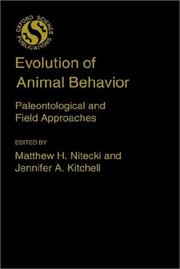| Listing 1 - 10 of 52 | << page >> |
Sort by
|

ISBN: 0202011771 020201178X Year: 1988 Publisher: New York, NY : Walter de Gruyter,
Abstract | Keywords | Export | Availability | Bookmark
 Loading...
Loading...Choose an application
- Reference Manager
- EndNote
- RefWorks (Direct export to RefWorks)
Behavior evolution. --- Homicide --- Psychological aspects. --- Droit pénal
Book
ISBN: 9781009019644 1009019643 1009022350 9781009467995 9781009011488 1009022601 1009467999 9781009022606 9781009022354 Year: 2024 Publisher: Cambridge : Cambridge University Press,
Abstract | Keywords | Export | Availability | Bookmark
 Loading...
Loading...Choose an application
- Reference Manager
- EndNote
- RefWorks (Direct export to RefWorks)
The biological world is full of phenomena that seem to run counter to Darwin's insight that natural selection can lead to the appearance of design. For instance, why do organisms in some species divide reproductive labor? The existence of non-reproducing organisms in such 'eusocial' species looks to be at odds with an evolutionary theory which posits traits exist because they help organisms survive and reproduce. What is the evolutionary advantage of an insect being distasteful to its predators? The distastefulness appears designed to deter predators, but can only affect the predator's actions when the insect is eaten; it is hard to see how such a trait could be passed on. This Element will cover the shared foundations of evolutionary explanations for these and other seemingly puzzling phenomena, focusing on the concepts of inclusive fitness and kin selection.
Natural selection. --- Kin selection (Evolution) --- Behavior evolution.
Book
ISBN: 0511823010 0511721951 Year: 1997 Publisher: Cambridge : Cambridge University Press,
Abstract | Keywords | Export | Availability | Bookmark
 Loading...
Loading...Choose an application
- Reference Manager
- EndNote
- RefWorks (Direct export to RefWorks)
'Social' insects and arachnids exhibit forms of complex behaviour that involve cooperation in building a nest, defending against attackers or rearing offspring. This book is a comprehensive, up-to-date guide to sociality and its evolution in a wide range of taxa. In it, leading researchers review the extent of sociality in different insect and arachnid groups, analyse the genetic, ecological and demographic causes of sociality from a comparative perspective and suggest ways in which the field can be moved on. It contains fascinating accounts of the social lives of many different insects and arachnids, as well as tests of current theories of the evolution of social behaviour. The Evolution of Social Behaviour in Insects and Arachnids provides essential reading and insight for students and researchers interested in social behaviour, behavioural ecology, entomology and arachnology.
Insects --- Arachnida --- Behavior evolution. --- Social evolution in animals. --- Behavior.

ISBN: 0195040066 Year: 1986 Publisher: New York Oxford Oxford University Press
Abstract | Keywords | Export | Availability | Bookmark
 Loading...
Loading...Choose an application
- Reference Manager
- EndNote
- RefWorks (Direct export to RefWorks)
Animal behavior --- Behavior evolution --- Animaux --- Evolution --- Congresses --- Moeurs et comportement --- Congrès
Book
ISBN: 0511565534 Year: 1991 Publisher: Cambridge : Cambridge University Press,
Abstract | Keywords | Export | Availability | Bookmark
 Loading...
Loading...Choose an application
- Reference Manager
- EndNote
- RefWorks (Direct export to RefWorks)
This innovative book challenges the perceived view, based largely on long observation of artificially-fed chimpanzees in Gombe and Mahale National Parks, Tanzania, of the typical social behaviour of chimpanzees as aggressive, dominance seeking, and fiercely territorial. In polar opposition, all reports from naturalistic (non-feeding) field studies are of non-aggressive chimpanzees living peacefully in non-hierarchical groups, on home ranges open to all. These reports have been ignored and downgraded by most of the scientific community. By utilising the data from these studies the author is able to construct a model of an egalitarian form of social organisation, based on a fluid role relationship of mutual dependence between many charismatic chimpanzees of both sexes and other more dependent members. This highly and necessarily positive mutual dependence system is characteristic of both (undisturbed) chimpanzees and (undisturbed) humans who live by the 'immediate-return' foraging system.
Sociobiology. --- Human behavior. --- Primates --- Social behavior in animals. --- Social structure. --- Behavior evolution. --- Behavior.
Book
ISBN: 0333311175 0333311183 9780333311172 9780333311189 Year: 1995 Publisher: New York, NY : MacMillan,
Abstract | Keywords | Export | Availability | Bookmark
 Loading...
Loading...Choose an application
- Reference Manager
- EndNote
- RefWorks (Direct export to RefWorks)
Behavior evolution --- Evolution (Biology) --- Human behavior --- Human evolution --- Evolution du comportement --- Evolution (Biologie) --- Comportement humain --- Homme --- Evolution --- Human evolution. --- Human behavior. --- Behavior evolution. --- Gesellschaft --- Geschichte. --- Kultur. --- Kulturelle Entwicklung. --- Vor- und Frühgeschichte. --- Evolution (Biology). --- Vor- und Frühgeschichte (Epoche).

ISBN: 0521662737 Year: 2000 Publisher: Cambridge : Cambridge University Press,
Abstract | Keywords | Export | Availability | Bookmark
 Loading...
Loading...Choose an application
- Reference Manager
- EndNote
- RefWorks (Direct export to RefWorks)
Animal behavior. --- Behavior evolution. --- Behavior genetics. --- Animal ethology and ecology. Sociobiology --- Sociology of culture --- ANIMAL BEHAVIOUR --- BEHAVIOUR --- EVOLUTION --- DEVELOPMENT --- GENETICS
Book
ISBN: 0333714571 033391399X 9780333714577 Year: 2000 Publisher: Basingstoke: Palgrave,
Abstract | Keywords | Export | Availability | Bookmark
 Loading...
Loading...Choose an application
- Reference Manager
- EndNote
- RefWorks (Direct export to RefWorks)
Evolution. Phylogeny --- Human behavior. --- Human evolution. --- Behavior evolution. --- Comportement humain --- Homme --- Evolution du comportement --- Evolution --- #PBIB:2000.4 --- Comportement --- Phylogenèse --- Genetic psychology. --- Évolution du comportement. --- Psychologie génétique.
Book
ISBN: 0745012388 074501237X Year: 1992 Publisher: New York Harvester Wheatsheaf
Abstract | Keywords | Export | Availability | Bookmark
 Loading...
Loading...Choose an application
- Reference Manager
- EndNote
- RefWorks (Direct export to RefWorks)
History --- Animal ethology and ecology. Sociobiology --- Social psychology --- Psychologie génétique. --- Évolution du comportement. --- Psychologie comparée. --- Genetic psychology. --- Behavior evolution. --- Psychology, Comparative.
Book
ISBN: 9780198797531 0198797532 Year: 2021 Publisher: Oxford: Oxford university press,
Abstract | Keywords | Export | Availability | Bookmark
 Loading...
Loading...Choose an application
- Reference Manager
- EndNote
- RefWorks (Direct export to RefWorks)
Since the late 1980s the dominant theory of human origins has been that a 'cognitive revolution' (C.50,000 years ago) led to the advent of our species, Homo sapiens. As a result of this revolution our species spread and eventually replaced all existing archaic Homo species, ultimately leading to the superiority of modern humans. Or so we thought. As Clive Finlayson explains, the latest advances in genetics prove that there was significant interbreeding between Modern Humans and the Neanderthals. All non-Africans today carry some Neanderthal genes. We have also discovered aspects of Neanderthal behaviour that indicate that they were not cognitively inferior to modern humans, as we once thought, and in fact had their own rituals and art. Finlayson, who is at the forefront of this research, recounts the discoveries of his team, providing evidence that Neanderthals caught birds of prey, and used their feathers for symbolic purposes. There is also evidence that Neanderthals practised other forms of art, as the recently discovered engravings in Gorham's Cave Gibraltar indicate. Linking all the recent evidence, The smart Neanderthal casts a new light on the Neanderthals and the "Cognitive Revolution". Finlayson argues that there was no revolution and, instead, modern behaviour arose gradually and independently among different populations of Modern Humans and Neanderthals. Some practices were even adopted by Modern Humans from the Neanderthals. Finlayson overturns classic narratives of human origins, and raises important questions about who we really are
Neanderthals --- Bird remains (Archaeology) --- Birds --- Cognition and culture --- Behavior evolution --- Human evolution --- Social aspects --- History --- Neanderthals. --- Birds. --- Prehistoric peoples. --- Prehistoric animals in art. --- Birds - Social aspects - History
| Listing 1 - 10 of 52 | << page >> |
Sort by
|

 Search
Search Feedback
Feedback About UniCat
About UniCat  Help
Help News
News